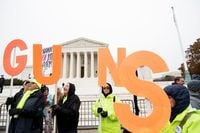On October 20, 2025, the U.S. Supreme Court announced it would hear a case that could reshape the intersection of gun rights and drug laws across the nation. The case, United States v. Ali Danial Hemani, centers on whether people who regularly use marijuana—or any other federally illegal substances—can lawfully own firearms. It’s a legal showdown that comes in the wake of the Court’s 2022 decision expanding Second Amendment protections, and it’s already drawing sharp lines between public safety, constitutional rights, and the evolving landscape of American drug policy.
The facts of the case are as tangled as the legal questions it raises. According to reporting from the Associated Press, the case began when federal agents searched the Texas home of Ali Danial Hemani. There, they found a pistol, approximately 60 grams of marijuana, and 4.7 grams of cocaine. Hemani, as detailed in court filings cited by Roll Call, admitted to the FBI that he used marijuana about every other day and acknowledged the cocaine was his. Prosecutors further alleged that Hemani was a drug dealer and, in court documents, even referenced supposed ties to an Iranian terrorist organization—though, notably, no terrorism-related charges were filed, and these claims are not part of the current Supreme Court case.
Instead, Hemani was charged under a federal law that makes it a felony for anyone who is an “unlawful user of or addicted to any controlled substance” to possess a firearm. This statute has been on the books for decades, and federal statistics cited by Bloomberg show that more than 200,000 people have been denied gun permits since 1998 due to drug use. The law’s reach is broad: despite about half of U.S. states now legalizing recreational marijuana, the drug remains illegal under federal law, putting millions of Americans at risk of violating gun statutes, according to Hemani’s defense team.
The legal drama intensified when the 5th U.S. Circuit Court of Appeals ruled that the blanket federal ban was unconstitutional—at least as applied to people who were not actively under the influence of drugs while possessing a firearm. The appellate judges concluded that the law could only be enforced if the defendant was “under the influence at the time of arrest with a firearm,” as Roll Call reports. This decision struck at the heart of federal enforcement, prompting the Trump administration to appeal to the Supreme Court. The administration’s position is a study in nuance: while it has championed robust Second Amendment rights, it argues that the ban on gun ownership by regular drug users is a “justifiable restriction” necessary for public safety.
In its appeal, the Trump administration wrote, “Courts should exercise the utmost vigilance in guarding that right from legislative or regulatory infringement. There are, however, narrow circumstances in which the government may justifiably burden that right.” The administration’s brief to the Supreme Court, as cited by Roll Call, claims the federal ban “addresses the dangerous combination of drugs and guns in a measured way, prohibiting the possession of firearms only by habitual users of illegal drugs and allowing a person to regain the ability to possess firearms simply by ceasing his habitual illegal drug use.”
The Justice Department further likened the modern ban to historical restrictions on “habitual drunkards” possessing weapons, arguing that the law is “a modest, modern analogue of much harsher founding-era restrictions.” They contend that “habitual illegal drug users with firearms present unique dangers to society—especially because they pose a grave risk of armed, hostile encounters with police officers while impaired.”
It’s not just federal law at stake. According to government filings and Bloomberg, at least 32 states and territories have enacted similar prohibitions. If the Supreme Court rules the federal ban unconstitutional, those state laws could also be swept aside, potentially changing the legal landscape for millions. The ripple effects could be profound: as Hemani’s lawyers argue, at least 20% of Americans have tried marijuana, and the risk of technical violations is widespread.
This case is the latest in a series of high-profile gun law challenges to reach the Supreme Court since its landmark 2022 ruling in New York State Rifle & Pistol Association Inc. v. Bruen. That decision, delivered by the Court’s conservative majority, held that firearm restrictions must have a strong grounding in America’s history and tradition to survive constitutional scrutiny. Since then, courts across the country have been reevaluating gun laws through this historical lens, leading to a patchwork of conflicting decisions.
Despite the expansion of gun rights, the Supreme Court has left room for some restrictions. Last year, in United States v. Rahimi, the justices upheld a federal law disarming individuals subject to certain types of domestic violence restraining orders. Chief Justice John Roberts, writing for the majority in Rahimi, stated that the government can ban gun possession by “categories of persons thought by a legislature to present a special danger of misuse.” The government’s argument in Hemani’s case leans heavily on this precedent, suggesting that habitual drug users represent such a category.
The case also exposes tensions within the conservative movement. The Trump administration, normally a stalwart defender of gun rights, finds itself arguing for a restriction that some of its usual allies oppose. The case, as Bloomberg notes, “puts the Trump administration in the position of arguing against gun rights,” potentially setting up a clash with gun rights advocates who see the ban as an overreach.
The justices are expected to hear oral arguments in early 2026, with a decision likely by June or July. The outcome could affect not only Hemani but also the more than 200,000 Americans who have been denied gun permits due to drug use over the past quarter-century, and countless others who might find themselves in legal jeopardy as state and federal marijuana laws continue to diverge.
Meanwhile, the Supreme Court’s docket reflects the ongoing national debate over the balance between individual liberties and public safety. Earlier this month, the Court agreed to hear a challenge to Hawaii’s restrictions on concealed carry permits, signaling that the justices are far from finished with the thorny questions surrounding the Second Amendment.
As the nation waits for the Supreme Court’s ruling in United States v. Hemani, the stakes couldn’t be higher. The decision will not only clarify the rights of gun owners who use marijuana or other drugs but could also reshape the boundaries of federal and state power in regulating both firearms and controlled substances. For millions of Americans navigating the patchwork of drug and gun laws, the Court’s answer could mean the difference between lawful ownership and felony charges.
With arguments set for early next year, all eyes are on the Supreme Court as it prepares to weigh in on one of the most contentious intersections of law and society in modern America.




